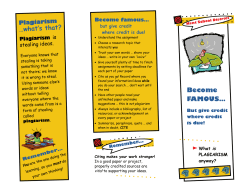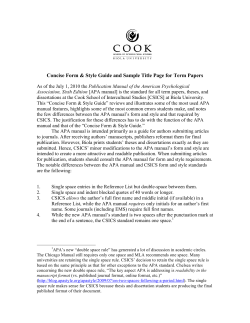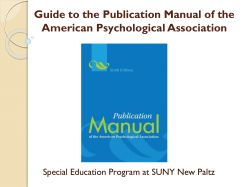
How to Avoid Plagiarism
How to Avoid Plagiarism
According to the definition given in the 1997 New
Webster's Encyclopedic Dictionary of the English
Language, plagiarism is "the unauthorized use of the
language and thoughts of another author and the
representation of them as one's own" (508).
Created by Ashlee Norris
Western Washington University
1
Can't I avoid problems just by listing
every source in the bibliography?
No, you need to integrate your
acknowledgements into what you're
saying. Give the reference as soon
as you've mentioned the idea you're
using, not just at the end of the
paragraph. It's often a good idea to
name the authors ("X says" and "Y
argues against X,") and then
indicate your own stand ("A more
inclusive perspective, however, . . .
").
This system of small raised
numbers signaling footnotes or
endnotes, followed by a
bibliography, used to be the
standard method of documentation.
You can choose either endnotes or
footnotes, according to
convenience (and let your wordprocessor help you deal with them).
Example
Renaissance audiences would have recognized handwriting as a signal for inner distress,4 specifically for
a condition that the Elizabethan author Reynolds
named "ague of the spirits."5
Notes
4 Joan Brown, The Renaissance Stage (Toronto:
University of Toronto Press, 2000), 111.
5 Peter Reynolds, The Player's Chapbooke, 1587;
quoted in Aline Mahieu, Acting Shakespeare
(Toronto: Gibson, 2003), 69.
Bibliography
Brown, Joan. The Renaissance Stage. Toronto:
University of Toronto Press, 2000.
Mahieu, Aline. Acting Shakespeare. Toronto: Gibson,
2003.
1
If I put the ideas into my own words, do I still have to
clog up my pages with all those names and numbers?
If you are directly quoting from a work, you will need to include the
author, year of publication, and the page number for the reference.
Example:
In a recent study of student performance (Jones, 1998), ...
Sorry—yes, you do. In
academic papers, you
need to keep mentioning
authors and pages and
dates to show how your
ideas are related to those
of the experts.
If there is no author to cite, such as when you are citing a web page
that lists no author, use an abbreviated version of the title of the
page in quotation marks to substitute for the name of the author.
Example:
A similar study was done of students learning to format research papers
("Using APA," 2001).
It's sensible to use your
own words because that
saves space and lets you
connect ideas smoothly.
But whether you quote a
passage directly in
quotation marks,
paraphrase it closely in
your own words, or just
summarize it rapidly, you
need to identify the
source then and there.
If you are citing a work that has no author and no date, use the first
few words from the title, then the abbreviation n.d. (for "no date").
Example:
In another study of students and research decisions, it was discovered
that students succeeded with tutoring ("Tutoring and APA," n.d.).
To cite a personal communication such as an interview or an e-mail,
provide initials and last name of the communicator, the words
personal communication, plus an exact date in the body of your
paper.
Example:
P. Smith also claimed that many of her students had difficulties with APA
style (personal communication, November 3, 2002).
2
That applies to Internet
sources too: you still
need author and date as
well as title and URL.
1
But I didn't know anything about the subject until I
started this paper. Do I have to give an
acknowledgement for every point I make?
You're safer to over-reference than to skimp. But you can cut down
the clutter by recognizing that some ideas are "common knowledge"
in the field—that is, taken for granted by people knowledgeable
about the topic.
You don't need to name a specific source for them, even if you
learned them only when doing your research. In some disciplines,
information covered in class lectures doesn't need
acknowledgement. Some interpretive ideas may also be so well
accepted that they don't need referencing: that Picasso is a
distinguished modernist painter, for instance, or that smoking is
harmful to health.
Check with your professor or TA if you're in doubt whether a specific point is
considered common knowledge in your field.
1
So what exactly do I have to
document?
With experience reading academic prose, you'll soon get
used to the ways writers in your field refer to their
sources. Here are the main times you should give
acknowledgements:
Quotations, paraphrases, or summaries.
Specific facts used as evidence for your
argument or interpretation.
Distinctive or authoritative ideas, whether
you agree with them or not.
1
Quotations
Quotations come from somewhere, and your reader will want to
know where. Don't just parachute quotations into your essay without
providing at least some indication of who your source is. Letting your
reader know exactly which authorities you rely on is an advantage: it
shows that you have done your research and that you are well
acquainted with the literature on your topic.
Example:
The ancient Greeks never saw a need to justify wars that were waged
outside the walls of the city state. "Hence we must turn to Roman
antiquity to find the first justification of war, together with the first notion
that there are just and unjust wars" (Arendt 12).
1
Paraphrase
Whenever you paraphrase, remember these two points:
1.
You must provide a reference.
2.
The paraphrase must be entirely in your own words. You must do more than merely substitute
phrases here and there. You must also completely alter the sentence structure.
To paraphrase means to express someone else's ideas in your own language. To summarize means to
distill only the most essential points of someone else's work.
Example:
The original passage is from Oliver Sacks' essay "An Anthropologist on Mars":
The cause of autism has also been a matter of dispute. Its incidence is about one in a thousand, and it occurs throughout
the world, its features remarkably consistent even in extremely different cultures. It is often not recognized in the
first year of life, but tends to become obvious in the second or third year. Though Asperger regarded it as a
biological defect of affective contact—innate, inborn, analogous to a physical or intellectual defect—Kanner
tended to view it as a psychogenic disorder, a reflection of bad parenting, and most especially of a chillingly
remote, often professional, "refrigerator mother." At this time, autism was often regarded as "defensive" in
nature, or confused with childhood schizophrenia. A whole generation of parents—mothers, particularly—were
made to feel guilty for the autism of their children.
What follows is an example of illegitimate paraphrase:
The cause of the condition autism has been disputed. It occurs in approximately one in a thousand children, and it exists
in all parts of the world, its characteristics strikingly similar in vastly differing cultures. The condition is often not
noticeable in the child's first year, yet it becomes more apparent as the child reaches the ages of two or three.
Although Asperger saw the condition as a biological defect of the emotions that was inborn and therefore similar
to a physical defect, Kanner saw it as psychological in origin, as reflecting poor parenting and particularly a
frigidly distant mother. During this period, autism was often seen as a defense mechanism, or it was
misdiagnosed as childhood schizophrenia. An entire generation of mothers and fathers (but especially mothers)
were made to feel responsible for their offspring's autism (Sacks 247-48).
1
Summaries
Summary moves much farther than paraphrase away from point-bypoint translation. When you summarize a passage, you need first
to absorb the meaning of the passage and then to capture in your
own words the most important elements from the original
passage. A summary is necessarily shorter than a paraphrase.
Here is a summary of the passage from "An Anthropologist on
Mars":
In "An Anthropologist on Mars," Sacks notes that although there is
little disagreement on the chief characteristics of autism,
researchers have differed considerably on its causes. As he
points out, Asperger saw the condition as an innate defect in the
child's ability to connect with the external world, whereas Kanner
regarded it as a consequence of harmful childrearing practices
(247-48).
1
Specific facts used as evidence for
your argument or interpretation.
Examples:
First consider whether the
facts you're mentioning are
"common knowledge"; if so,
you may not need to give a
reference.
But when you're relying on
facts that might be disputed
within your discipline—perhaps
newly published data—
establish that they're
trustworthy by showing that
you got them from an
authoritative source.
In September 1914, more than 1300
skirmishes were recorded on the
Western Front.
Other recent researchers confirm the
findings that drug treatment has little
effect in the treatment of pancreatic
pseudocysts.
1
Distinctive or authoritative ideas,
whether you agree with them or not.
The way you introduce a reference can indicate your
attitude and lead into your own argument.
Example:
(MLA example) Writing in 1966, Ramsay Cook asserted that Canada was in
a period of critical instability (174). That period is not yet over, judging by the
same criteria of electoral changeability, economic uncertainty, and confusion
in policy decisions.
(APA example) One writer (Von Daniken, 1970) even argues that the Great
Pyramid was built for the practical purpose of guiding navigation.
1
References
1 Procter, M. (2004). How to avoid
plagiarism. January 18, 2005, from
http://www.utoronto.ca/writing/plagsep.
html
2 Neyhart, D., & Karper E. (2001). Using
American Psychological Association
(APA) Format (Updated to 5th Edition).
January 18, 2005, from
http://owl.english.purdue.edu/handouts
/research/r_apa.
html#Your%20Reference%20List
Resources For You To Check out
Western Washington University Writing Center Located Wilson Library 667
360-650-3219
http://www.library.wwu.edu/ref/plagiarism.html
http://www.ac.wwu.edu/~soc/plagiarism.PDF
Washington State University
http://www.wsulibs.wsu.edu/electric/trainingmods/plagiarism_test/main.html
Owl Writing Center at Purdue University
http://owl.english.purdue.edu/handouts/research/r_apa. html#Your%20Reference%20List
APA Citations
http://www.lib.usm.edu/research/guides/apa.html
MLA Citations
http://www.ccc.commnet.edu/mla/index.shtml
© Copyright 2025





















